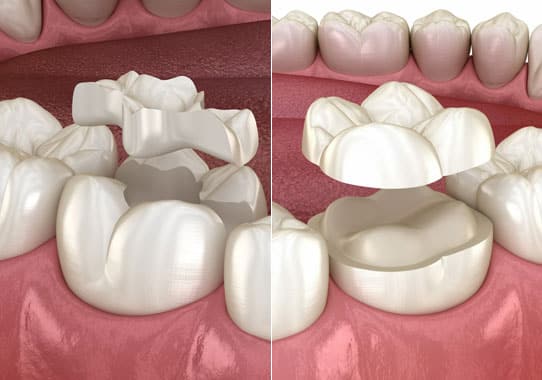
Traditional Cavity Treatment
Cavities are typically treated with either an amalgam or a composite resin filling. An amalgam filling is made up of a mixture of metals suspended in liquid mercury. When cured, it is exceptionally hard and can withstand very strong bite forces. However, it is silver in color, and the mercury content often raises concerns. Additionally, when placed on the chewing surface of a molar, the filling can act as a wedge and can cause further damage.
Composite resin fillings provide an alternative to amalgam. Made up of plastic, fine glass and other materials, these fillings are tooth colored. They do not contain any metals or any mercury. However, they are not as strong as amalgam. If placed on the chewing surface of a molar, the pressure could cause the filling to break.

Inlays and Onlays
Inlays and onlays are an alternative to traditional fillings, commonly used to treat cavities in the chewing surfaces of your molars. While they can be made from a few different types of materials, they are commonly made from ceramic. Ceramic blends in beautifully with the color of the natural tooth, rendering the restoration invisible.
Both of these fillings are commonly called indirect fillings. This is because, unlike traditional fillings which are cured inside of the tooth, they are created outside of the tooth and then cemented into place. An inlay treats a cavity that affects only one cusp of the molar while an onlay treats a tooth that has two or more cusps affected by decay.
Inlay and Onlay Procedure
Getting your inlays or onlays is typically a two-appointment procedure. At your first appointment, we clean the tooth and take impressions. Cleaning the tooth involves the use of a drill to drill away the decay. After the tooth has been thoroughly cleaned, we take an impression. This impression will be sent off to our dental lab, where your inlay or onlay is designed and then created.
It can take up to two weeks for the restoration to be completed and sent back. During this time, a temporary filling is placed to protect the tooth. Once it is ready, you return for your second appointment. We check the restoration for fit and color and cement it into place.
Benefits of Inlays and Onlays
They strengthen the affected tooth, rather than compromising it.
Less drilling of the tooth is needed.
Less invasive than a crown.
They are more affordable than crowns.
The fillings are made to fit perfectly inside of the cavity. Unlike traditional fillings, which can shrink inside the cavity during curing, this is not an issue with inlays and onlays.
Ceramic restorations blend in perfectly with the color of your natural teeth. There is also no metal or mercury to worry about.
